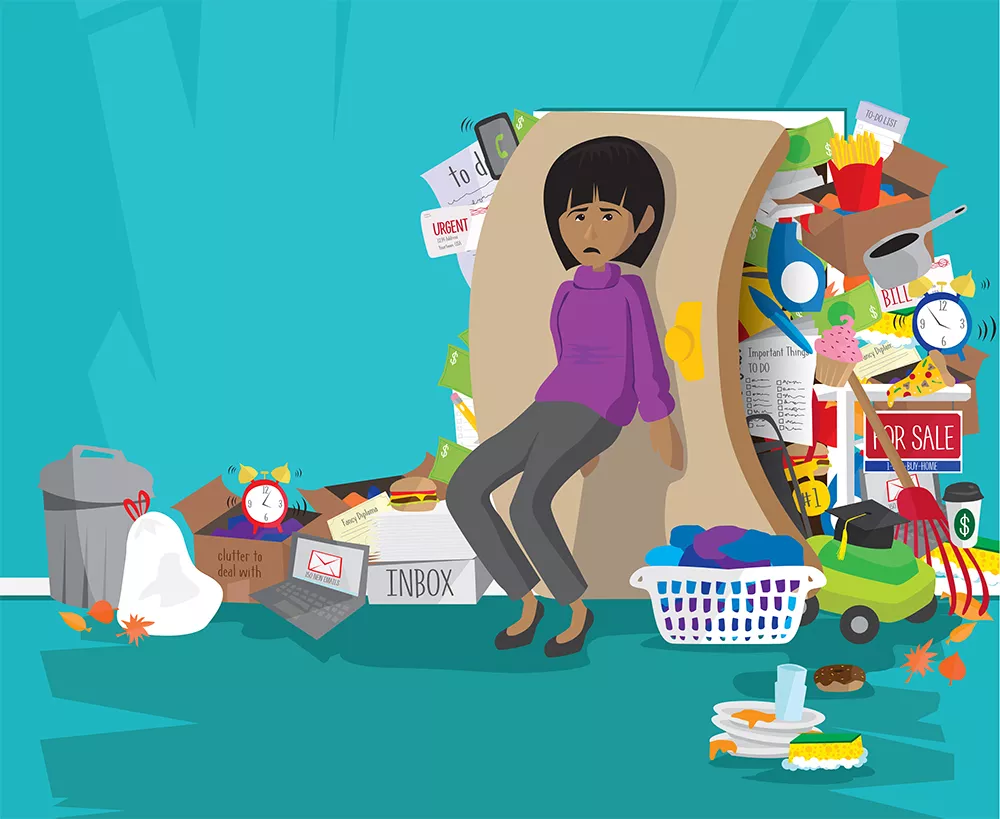The holidays and new year can bring up all kinds of stress — from trying to meet heightened expectations, to worries over money, regret over missed opportunities, or even a general discomfort over "who and where we are and where and who we want to be in the next year." says Gonzaga University leadership program faculty member and life coach Christina Geithner.
"The stress response is a natural response of living things when the challenge at hand exceeds our resources and capacities," says Geithner, who notes that stress can take a lot of forms. Still, despite the broad array of responses — from physical symptoms like sweaty palms, a pounding heart, or churning stomach to emotional responses like fear, anger or even excitement and astonishment — many of us are so accustomed to being under siege that we don't even realize the toll it is taking on our bodies.
"What works to reduce stress is to notice when you are stressed, acknowledging your experience and practicing pausing and choosing a more useful response in the moment," says Geithner.
Read on for practical ways to tackle some of our most common stress-inducing situations.
I'M GRUMPY!
Here's the deal. We're inherently a negative bunch. That's because the brain is wired to react to danger, in the process devoting more attention to avoiding threats (i.e., negative things) than it does to basking in warm and fuzzy feelings. It's called a "negativity bias" and sometimes you're going to need to tame it. If you're feeling out of sorts, a quick inventory of what is, in fact, going well may be just the ticket. Geithner calls it an "appreciative inquiry."
"As the saying goes, 'Where our attention goes, energy flows.'" She recommends spending a few minutes each day keeping a gratitude journal, or even just making a mental note of the things we are grateful for: "Gratitude is one of the keys to resilience — the capacity to bounce back or recover from life's challenges. When we take time to be grateful for the people, circumstances, and things in our lives, our quality of life is improved. It's that simple!"
Another way to climb out of a bad mood is to reframe seemingly negative events. For example, Geithner tells of being stuck in a traffic jam that might have meant missing an important event. Instead of focusing on the frustration, she and her husband turned their attention to being grateful they weren't involved in the accident that caused the slowdown, and then "enjoyed the sunshine and changing colors on an extraordinarily beautiful fall day."
Your physical state can also have a dramatic impact on your mental state. It's well known that exercise helps improve mood, but short of that, simply smiling can help you feel happier. Research shows that the act of smiling changes the chemistry in your brain, and just doing it will take some of the edge off that innate negativity bias.
And finally, consider steering clear of social media. A 2016 study showed that the more social media platforms a person engaged with, the more likely they were to experience symptoms of depression and anxiety. In particular, negative online experiences — including "gaffes, unwanted contacts or cyberbullying" — increased the risk for depression. Notably, more than 80 percent of study participants reported at least one negative experience on Facebook, while 60 percent had four or more.
Noticing that you're feeling stressed and taking steps to change how you react is a skill. "Like most skills, it takes intention and practice. And it's doable," says Geithner.
ARRRGH, I ATE TOO MUCH!
Food undeniably plays an important role in celebrations — there are often foods that are only available at certain times of the year, and family favorites that bring back happy memories. Korrin Fotheringham, a Registered Dietitian Nutritionist and owner of Spokane's Northwood Nutrition, says it is important not to feel deprived: "We should enjoy those foods and enjoy them with those we love."
Food is not just about eating; the whole experience can be savored. For example, rather than just sitting down to eat, consider taking part in the ritual of preparing food and spending time talking about family history related to the food; in short, doing things that help to "nourish our bodies, but also our souls," she says, can create a richer experience outside the simple act of eating.
Taking an active role in making sure there are some healthy choices to round out a festive plate can be also helpful. "Is there anything green on the table?" Fotheringham asks. If not, take charge of making sure there is. "One favorite that I like to share is Brussels sprouts with crisp bacon and maple syrup." She also recommends a Honeycrisp apple and kale salad as a nice addition to any celebratory table.
When it's time to eat, it's important to approach the buffet line with a sense of awareness. "It is very much about balance and giving ourselves permission to enjoy these foods that may not come around very often," says Fotheringham. "That may look like taking little bites of everything. After you're done with that, be cognizant of checking in and seeing if you are still hungry."
What about the pressure to "Just try some!" that excited cooks can exert? She notes it's OK to say "No, thank you" or "Maybe later" if there's pressure to eat something you don't particularly want or just aren't hungry for.
Though most people have the ability to regulate their own hunger and rely on their own hunger cues, Fotheringham cautions that overeating until you are uncomfortably full multiple times can be a problem, because it "could set your body up to wanting to feel more full than it needs to be."
MY HOUSE IS A MESS!
"Hey, we're in the neighborhood and thought we'd stop by!" Those heart-stopping words are often followed by a perimeter scan: What can be done in the next 10 minutes to spruce the place up?
"You worry about the area where everybody is going to be," says Cindy Vanhoff, a Spokane Valley professional organizer and owner of reclaimed spaces. "The bathroom or the kitchen. Just box up the stuff that is your everyday nemesis. But then after the party or after the people come over, you have to deal with it."
While your home doesn't have to be "party ready" at all times, Vanhoff says there are some habits that can make spiffing the place up a snap: number one is the Ten Minute Tidy. "Everybody in the family spends 10 minutes each night tidying up the house. The key to staying clutter-free is maintenance every day. Every day. Is that reality? No, because we get busy, but if you do it every day that you can, even if you do it four times a week, that's more than zero, right?"
A Ten Minute Tidy is most effective when there is underlying structure. "In order to truly be organized, there needs to be a place for everything, and everything in its place. My mom used to tell me that and I hated it, but it is so true," Vanhoff says. A trouble spot for many clients is what to do with mail. Here are some tips: First, get off mailing lists. Put unwanted mail immediately into the recycling bin. Have a separate basket for shredding and filing.
"Clutter is just postponed decisions," says Vanhoff. "We're in such a hurry, we think, 'I'll just set it here for now.' 'For now' are two words that should not be in our vocabulary, because oftentimes it is there 'for now' for a long time."
In addition to the Ten Minute Tidy, Vanhoff recommends the Two Minute Rule: "If it takes two minutes or less to do it, just do it... If you ever time yourself, you can do a lot in two minutes. And if you can do that 90 percent of the time, you are going to be decluttered." So put the clothes in the hamper, go ahead and put that dirty dish right into the dishwasher — no need for a stop in the sink.
One cause of clutter is simply having too much stuff. Struggling with what to hang onto? Here's some tough news: "My kids are in their 30s, and I really don't think they are interested in much of our stuff," Vanhoff says. "And most people under 40 I would say are not interested in their parents' things."
And finally, Vanhoff says it's important not to feel too bad about less-than-perfect homes. "People need to realize too that you go into someone's home and it looks gorgeous, but you don't know that they didn't just stuff everything in a box and put it in the office," she says from experience. "You don't know what their closets look like. Sometimes we compare ourselves and we don't know what is hidden behind closed doors." she says, laughing.
TIP: When you're planning to declutter, start in the most used space. It's the most rewarding, because you can see it. But keep in mind that you'll need to give yourself two-and-a-half times longer than you think it will take. "We often don't give ourselves enough time to complete a task," says Vanhoff. "Stop, take a breath and work your way around the room. Start in one place and hang out in that place before moving on."
THESE PEOPLE ARE DRIVING ME CRAZY!
Ah! The anticipation! Meaningful time with family and friends is what the holidays are all about. There's finally an opportunity to spend more extended time together. What could be better?
Unfortunately, things can get rocky for all kinds of reasons: conversations that drift into uncomfortable territory or the crash of reality against heightened expectations. Social media can reinforce the impression that your together-time experience is falling far short of the joyous photos shared by others.
The first step to enjoying the company of family and friends is actually a solitary one: You have to prioritize your own needs. "Taking care of yourself helps you be more present, available and better equipped to deal with or help meet someone else's needs," says Geithner. That can mean something as simple as getting some exercise, or having a snack before leaving home so you're not "hangry" when you arrive at a gathering.
If frustration, irritation or anger begin to mount while you are interacting with others, "pause and zoom out: literally or figuratively step out of the situation for a moment and take the 10,000-foot view of what is happening," says Geithner. Then ask yourself, "What is most important here?" Guess what? You're not going to change other people. What you do control is how you react.
It's easy, and quite common, to view others in terms of how they relate to your needs and desires — perhaps they are a "thorn in your side, an obstacle in your way or critical to your success." says Geithner. Instead, try to consider the person as "a complete and beautifully imperfect human being — like yourself." Recognize that for the most part, people have good intentions, are most likely fighting battles you aren't even aware of, and generally are doing the best they can to make sense out of the messiness of life. In short, show compassion and be prepared in advance not to take things personally. If you find you're still getting angry or frustrated, a quick break to another room or a short walk can help soothe your feelings. Consider reaching out to a supportive friend, or if things seem destined to spiral downward, give yourself permission to prioritize your own well-being and head home.
I HAVE TOO MUCH TO DO!
Overwhelmed by too many tasks and not enough time? Here's a step-by-step guide to finding calm.
Write it all down
"I always use a time map," says Cindy Vanhoff, professional organizer and owner of reclaimed spaces in Spokane Valley. "It is basically your week on a piece of paper, by the hour. Fill it with your have-to-dos, and then fill in the things that you want to do. You don't fill it up 100 percent. You need to always have free time." Don't forget to include things you need to do to take care of yourself: time for exercise, journaling or meditating, says Gonzaga University leadership program faculty member and life coach Christina Geithner.
Prioritize
You can't do it all. Geithner recommends considering the following questions: Which project is most important for me to give my attention and energy to right now — for today? For this week? For this month? What action will make the biggest difference in the quality of this day or will help move things forward? "Keep the action list short," she says. "One to three to-do's that will make a significant difference."
Share the load
"My motto is finding the time to do the things you love with those you love," says Vanhoff. That can mean delegating tasks: "What can you give your kids to do or to your partner?" Set up carpools for kids, and, "if you can afford it at all," consider hiring help for household duties. We usually put off doing what we don't particularly like to do.
Analyze the situation
Talking about your feelings of frustration over too much to do can be helpful. Just getting a second set of eyes on the problem may reveal solutions. "We have a-ha! moments when we are talking with somebody," Vanhoff notes. Sometimes in really thinking about a to-do list, you'll realize there are things you just need to accept as they are. "We can pick our battles, and some choices only require that we shift our attention and perspective," says Geithner.
Let it go
Vanhoff says she used to try to do it all, but that's changed: "Just being in my business and watching people, I see how not having enough time is overwhelming." Instead of letting your to-do list rule your life, she says it's important to take a step back and think about what you want to do. "If something has been on your to-do list for a year, do you really need to do it?" she asks. Even with your hour-by-hour weekly plan in place, life happens. A kid needs to visit the urgent care. Things just don't get done. "And you have to be OK with that," Vanhoff says. "Give yourself a little grace!" Geithner echoes that thought. "Realizing we can't do everything, be everything to everyone, or be perfect goes a long way to reducing stress and increasing contentment." And that's a good thing, she adds. "If we could do everything, be everything to everyone, and be perfect, life would be boring and without rich opportunities for learning and development."























